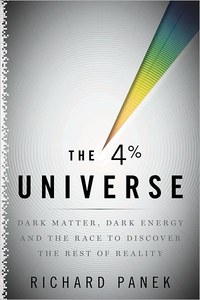Review: The Four Percent Universeby Jeff Foust
|
| The work leading to the discovery of dark energy, and its aftermath, is told in the book as very much a human saga and not a sterile account of the advance of science. |
The book’s title comes from the fraction of the universe comprised of ordinary, baryonic matter (although if one is willing to round up, the book could be called The Five Percent Universe: the latest analysis of data from NASA’s WMAP spacecraft, mentioned in the book’s epilogue, pegs that fraction at 4.56%.) Another 22.7 percent of the universe is what’s known as dark matter, which can’t be directly detected (not yet, at least) but makes is presence known gravitationally, most famously in the rotational curves of galaxies. The rest—nearly three-quarters of the universe—is dark energy, an energy that pervades the universe and, as astronomers discovered less than 15 years ago, is causing the expansion of the universe to accelerate.
The heart of The Four Percent Universe is the discovery of dark energy in the late 1990s by two separate, competing teams of astronomers and physicists. They were seeking to understand whether the universe would continue to expand forever, or if the expansion would stop and the universe collapse upon itself in a Big Crunch. The efforts, the Supernova Cosmology Project and the High-z team (z is astronomical shorthand for redshift) searched for supernovae in distant galaxies, using them to calibrate their distances. Both groups found that not only was the universe continuing to expand, its expansion was accelerating, an outcome that required the presence of a heretofore unknown force—dark energy, as it came to be known—revolutionizing cosmology.
The work leading to the discovery of dark energy, and its aftermath, is told in the book as very much a human saga and not a sterile account of the advance of science. Panek interviewed dozens of people for the book, including key scientists on both supernova teams. While dedicated in their work to help unravel the secrets of the universe, these scientists were also very much human, seeing the other team as rivals, suspicious of their work while worrying about being scooped. At times some of them seem more concerned about who will be judged to be first to discover the universe’s accelerating expansion and thus reap the fame and rewards (including, perhaps, someday the ultimate prize: a Nobel). For now, the race is judged to have ended in a virtual tie, with the two teams splitting many of the prizes their discovery has earned.
With all the emphasis on the discovery of dark energy, the study of dark matter gets a little, well, overshadowed in the book. There’s a discussion of the discovery of dark matter, when Vera Rubin and colleagues found that the rotational profiles of galaxies they studied could only be explained if the galaxy was surrounded by a massive halo of invisible matter. Later in the book Panek looks at some of the efforts to try and directly detect dark matter—whatever it may be—with various experimental efforts. But he devotes far more of the book to dark energy, although perhaps proportional to dark energy’s preponderance in the universe vis-à-vis dark matter.
Unlike many other astronomy books, The Four Percent Universe contains no images or illustrations: no pictures of distant galaxies, no illustrations of the Big Bang or the inflation model, not even pictures of the key people in the book. However, there’s a good chance you won’t notice that lack of imagery until you’re well into the book, as Panek does a fine job illustrating the concepts, and the people, with only his words. The book, and the unsolved mysteries contained within about the nature of the universe, is a reminder of the wisdom of Haldane’s words.
